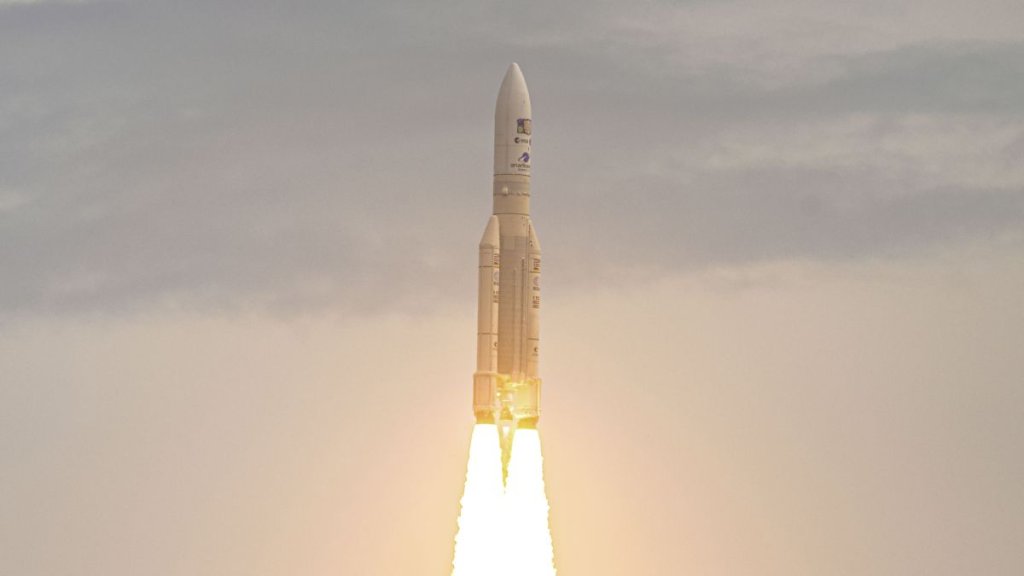
Watch Europe’s Jupiter-bound JUICE spacecraft speed away from Earth in these photos by amateur astronomers (Image Credit: Space.com)
Amateur and professional astronomers alike came together on Friday, April 13 to capture the Jupiter Icy Moons Explorer (JUICE) spacecraft as it headed away from Earth on its eight-year trip to Jupiter.
The European Space Agency (ESA) JUICE mission departed from the European Spaceport in Kourou, French Guiana, at 08:14 EDT (1214 GMT) journeying aboard an Ariane 5 rocket. Skywatchers were keen to track the progress of the spacecraft which will arrive in the Jovian system in 2031.
Open University Post-Doctoral Research Associate Samuel L. Jackson caught several images of JUICE over its first two days in space using the Open University’s PIRATE and COAST telescope at the Observatorio del Teide, Tenerife. Jackson shared the images as time-lapse footage on his Twitter feed (opens in new tab) on Sunday, April 15.
Related: Europe’s Jupiter Icy Moons Explorer is unlikely to find life. Here’s why.
Spotted: @ESA_JUICE on it’s way to Jupiter! I managed to capture a sequence of images of the JUICE spacecraft that launched today using our @PirateOU telescopes in Tenerife. @OU_SPS @OpenUniversity @esaoperations #JUICE #ESA #Telescopes pic.twitter.com/QHAYCZfkjkApril 15, 2023
“From a (very) rough calibration of the data last night it seems it was getting fainter by about 4.9 magnitudes per day,” Jackson said. “Going to try to spot it again tonight but since it’ll be roughly 100 times fainter, it might be hard to spot as clearly!”
Citizen scientist Petri Kuossari also spotted the JUICE spacecraft, this time from Finland, and also captured the second stage of the Ariane 5 rocket which carried the craft to space. The image was shared by SETI Institute astronomer Frank Marchis on his Twitter feed (opens in new tab).
Juice and Ariane launch vehicle observed by Petri Kuossari from Finland with his @unistellar eVscope. pic.twitter.com/sotr27yMWMApril 16, 2023
Twitter user Guillet Bruno also caught a glimpse of the JUICE spacecraft heading away from Earth, bidding the mission bon voyage.
“Have a nice journey #JUICE to Ganymede, Callisto, Europa and Jupiter. See you during your next 🌍🌜 flyby in august 2024,” Bruno said in the tweet (opens in new tab).
As noted by Bruno, space enthusiasts and astronomers will get another chance to spot JUICE close to Earth when it approaches our planet for a gravity assist in August 2024. At that time, the ESA spacecraft will perform the first-ever gravity assist using at the same time the gravitational forces of Earth and its moon to alter the spacecraft’s orbit.
Have a nice journey #JUICE to Ganymede, Callisto, Europa and Jupiter. See you during your next 🌍🌜 flyby in august 2024 🛰@ESA_JUICE @Unistellar #evscope #DestinationJupiter pic.twitter.com/hn6Z0A3Pf9April 15, 2023
After this lunar-Earth gravity assist, JUICE will head toward Venus, the second planet from the sun for another gravity assist in 2025. After that, it will visit Earth twice more, in 2026 and 2029, to get additional energy boosts, offering additional opportunities to astronomers of varying skill levels to catch it.
After the 2029 Earth flyby, JUICE will finally head toward Jupiter and three of its four largest moons, Europa, Callisto and Ganymede (opens in new tab), also known as the Galilean moons, due to the fact they were discovered by Italian astronomer Galileo Galilei in the 1600s.
The primary mission of JUICE will be to investigate the subsurface oceans believed to dwell beneath the icy shells of these Jovian moons. This could help determine if any of these moons possess the conditions needed to support life.
Follow us on Twitter @Spacedotcom or on Facebook.





